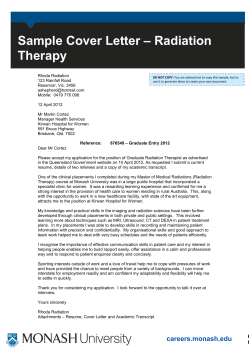
Chemistry 4860/6860 Problem Set #1 1.
Chemistry 4860/6860 Problem Set #1 1. You are in charge of selecting a new UV-visible scanning spectrophotometer for your industrial research laboratory. The laboratory mostly does spectral scanning to ascertain if certain impurities are present in one of their products. If they find the impurity, they use the spectrophotometer at a fixed wavelength to accurately determine the concentration of the impurity. At a recent instrument exhibit, you note that there are two different types that seem to fit your needs. A new microprocessor-controlled single-beam spectrophotometer sells for $15,000. It scans the spectrum of the reference cuvette and stores that in memory. It then scans the spectrum of the sample cuvette and automatically obtains the ratio (i.e., transmittance) and calculates the absorbance. The second system to fit your needs is a true double-beam system (also microprocessor-controlled) that sells for $25,000. Compare the advantages and limitations of these two types of spectrophotometers for your application. Recommend to your supervisor one of the two systems. How would your recommendation change if you also consider a diode array spectrophotometer with 2-nm resolution that sells for $15,000? 2. A sample is illuminated with 1.0 ¼ W of radiation and transmits 90% of the incident radiation. Calculate the maximum value of the luminescence radiant power that could be observed. 3. Consider an F/2 lens that is 5.0 cm in diameter. A light source is placed 10 cm from the lens. Where is the image focused and what is the magnification? What are the F/n of the system and the solid angle collected? 4. Calculate the numerical aperture and F/n for a fiber optic with core and cladding refractive indices of 1.50 and 1.48, respectively. 5. What performance characteristics of a monochromator are affected when only the grating groove density is changed? 6. A ray in air is incident on a block of crown glass (· glass = 1.52) at a 30o angle from the normal to the glass surface. At what angle relative to the normal will the ray be transmitted through the glass? 7. 8. A grating has a groove density of 1500 grooves per mm. If the incident beam strikes the grating at an angle of 20.0o: (A) What diffraction angles will the first order of 300, 400, 500, 600 and 700 nm appear? (B) What wavelength in the second order overlaps the 600 nm first-order beam? (C) What is the free spectral range for the first order at 600 nm? (A) If the grating in problem 7 is blazed at an angle of 15.0o, what is the blaze wavelength? (B) At what angle would the grating in part (A) need to be blazed to obtain a 450-nm blaze wavelength? 9. Why are mirrors preferred over lenses for imaging in many spectroscopic instruments that must cover multiple wavelengths? If lenses must be used, how can their imaging properties be idealized at least for two wavelengths? What are the disadvantages of this approach? 10. At 589 nm, the focal length of a lens is 5.0 cm and · = 1.544. At 200 nm, the refractive index is 1.651. Calculate the focal length at this wavelength. If the lens was used at 589 nm for 1:1 imaging, where is the image focused at 200 nm? 11. A line source is scanned with a monochromator at 5.0 nm min -1. On a recorder, a triangular peak is observed with a half-width of 1.0 nm with a chart speed of 2.0 cm min -1. Calculate the spectral bandpass of the monochromator. 12. In photo counting, nonlinearity occurs at high photon fluxes because of pulse overlap effects (i.e., the probability of two photons generating photoelectrons within the response time or dead time of the detector or signal processor becomes significant). For some photon counting systems denoted paralyzable systems, the observed count rate rtis related to the true count rate r by rt = r(1 - rT) if rT < 0.13 where rT is the system deadtime in seconds. Calculate the true count rate for which the observed count rate is 1% low for a photon counting system with a dead time of 2 ns. 13. Describe the major differences between a nonlinearity due to stray radiation and that due to polychromatic radiation. What are the major causes of stray radiation in a monochromator? What steps are taken in many monochromators to reduce the stray radiation figure?
© Copyright 2025





















